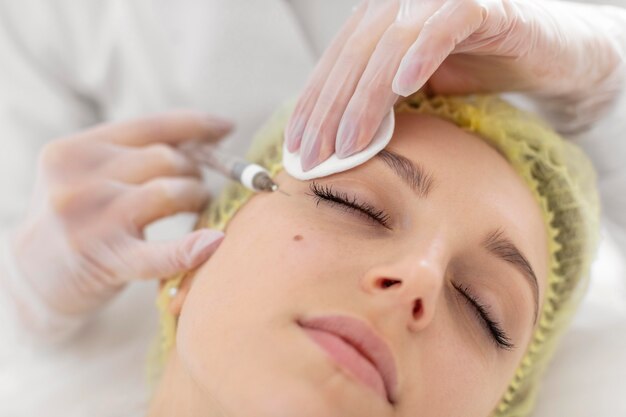Dark Circles treatment in Abu Dhabi under the eyes can be caused by various factors, including genetics, aging, lifestyle, and certain medical conditions. When it comes to surgical options to treat dark circles, the most effective approaches generally focus on addressing the underlying causes. Here are some of the best surgical options available for dark circles:
1. Blepharoplasty (Eyelid Surgery)
- Overview: Blepharoplasty involves the removal of excess skin and fat from the upper and/or lower eyelids. This procedure can significantly improve the appearance of dark circles caused by puffiness or excess skin.
- Benefits:
- Reduces puffiness and bags under the eyes.
- Improves overall eyelid appearance, making the eyes look more youthful and alert.
- Can be combined with other cosmetic procedures for enhanced results.
Recovery and Results
- Recovery can take 1-2 weeks, during which time swelling and bruising are expected.
- Results are often noticeable after the swelling subsides and can last for many years.
Pros:
- Offers a permanent solution for puffy eyes and bags.
- Dramatically reduces dark circles caused by shadowing.
- Tightens and rejuvenates the skin under the eyes.
Cons:
- Requires surgery with a recovery period of at least 1-2 weeks.
- Risks include infection, scarring, and changes in eyelid sensation.
2. Fat Transfer (Autologous Fat Grafting)
- Overview: In this procedure, fat is harvested from another area of the body (such as the abdomen or thighs) and injected into the under-eye area. This can help fill in hollows and improve the appearance of dark circles.
- Benefits:
- Provides a natural solution to volume loss under the eyes.
- Results are long-lasting as the injected fat can integrate with the surrounding tissue.
- Minimal scarring since the incisions are small.
Recovery and Results
- There is a recovery period of about 1-2 weeks. Some swelling and bruising are expected.
- Results can last several years, and in some cases, fat grafts can become permanent as the fat integrates into the surrounding tissue.
Pros:
- Natural, biocompatible material (your own fat).
- Long-lasting or permanent results.
- Can improve skin texture and hydration.
Cons:
- Requires two procedures: one for harvesting fat and one for injection.
- Some of the fat may not survive the transfer, requiring additional treatments.

3. Lower Eyelid Surgery (Transconjunctival Blepharoplasty)
- Overview: This specific type of lower eyelid surgery involves making incisions inside the eyelid to remove or reposition fat pads without external scarring. It is often used to treat dark circles caused by bulging fat or sagging skin.
- Benefits:
- Minimal scarring and a quicker recovery time.
- Directly addresses the fat deposits contributing to dark circles.
- Can improve skin texture in the lower eyelid area.
Recovery and Results
- Recovery is faster than traditional blepharoplasty, with less bruising and swelling.
- Full results can be seen in 1-2 weeks.
Pros:
- No visible scarring.
- Effectively treats fat protrusions that create dark shadows.
- Long-lasting results.
Cons:
- Does not address skin pigmentation or vascular dark circles.
- Requires a surgical procedure with associated risks.
4. Chemical Peels or Laser Resurfacing
- Overview: While not surgical in the traditional sense, these procedures can be effective in treating pigmentation and skin texture issues around the eyes. They help rejuvenate the skin and can lighten dark circles.
- Benefits:
- Improves skin tone and texture.
- Stimulates collagen production for more youthful skin.
- Can be performed in conjunction with surgical procedures for enhanced results.
Recovery and Results
- Recovery can take a few days to a week, depending on the intensity of the peel or laser treatment.
- Results are noticeable within a few weeks and continue to improve as the skin heals.
Pros:
- Non-surgical options that are effective for pigmentation issues.
- Can improve overall skin quality and texture.
- Minimal downtime compared to surgery.
Cons:
- May require multiple sessions for optimal results.
- Not effective for dark circles caused by fatty deposits or hollowness.
5. Thread Lift
- Overview: A thread lift involves using sutures to lift and tighten sagging skin under the eyes. While not specifically a treatment for dark circles, it can help improve the overall appearance of the lower eyelid area.
- Benefits:
- Minimally invasive with minimal downtime.
- Results can be seen immediately and improve over time as collagen develops.
- Provides a subtle lifting effect.
Recovery and Results
- Recovery is minimal, with mild swelling or bruising for a few days.
- Results are immediate and can last from 6 months to over a year, depending on the filler used.
Pros:
- Quick, non-invasive procedure.
- Immediate results with no downtime.
- Can be reversed if needed (in the case of hyaluronic acid fillers).
Cons:
- Temporary solution; maintenance is required.
- Not effective for pigmentation issues or excess fat.
6. Dermal Fillers
- Overview: Though not a surgical option, injectable fillers like hyaluronic acid can effectively treat dark circles caused by volume loss under the eyes. They fill in hollows, making the area appear more youthful.
- Benefits:
- Immediate results with minimal downtime.
- Non-invasive and can be done in an outpatient setting.
- Results can last several months to over a year, depending on the product used.
Conclusion
The best surgical option for treating dark circles largely depends on the individual’s specific condition, the underlying causes of their dark circles, and their desired results. Consulting with a qualified cosmetic surgeon or dermatologist is essential to determine the most appropriate treatment plan. They will evaluate factors such as skin type, age, and lifestyle to recommend the best procedure for achieving optimal results.







